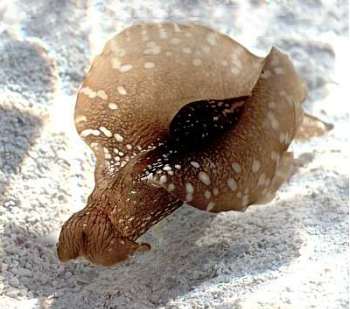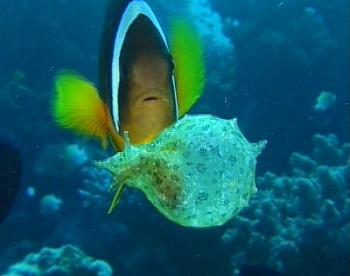

Aplysioidea - swimming
Order: ANASPIDEA
Superfamily: APLYSIOIDEA
PHOTO
PHOTO: Upper: Aplysia extraordinaria. Photo: Julie Marshall. Lower: Notarchus indicus. Photo: Jochen Scholtyssek
Sea Hares, like most sea slugs, use their large foot to crawl along the substrate. However many species are also able to swim by flapping their large wing-like muscular parapodia. Some swim rather awkwardly for a few minutes to escape some threat, but others seem to be able to swim for an hour or more, allowing them to travel some distance. Not all species can swim.
A very special case of 'jet propulsion' is found in Notarchus indicus in which the parapodia are fused together, except for a small opening at the anterior end. The fused parapodia mean that the body of Notarchus is effectively enclosed in its own bag or sac. By sucking water in and out of this small opening Notarchus becomes a jet propelled bag. During this swimming phase, it undergoes a series of backward somersaults. The result is quite spectacular, if not very elegant and appears designed to quickly remove Notarchus from a place of immediate danger, rather than as a means of serious movement from one place to another. [For further photos and a description of its swimming see messages #2633, #2658].
The related Akera can also swim, by flapping its parapodia.
There are many messages and discussions on the Forum concerning swimming in Sea Hares. Use the search button to find more examples and ideas.
-
Hamilton, P.V., 1984. Factors influencing the water speed of swimming sea hares, Aplysia brasiliana. Animal Behaviour, 32: 367-373.
-
Hamilton, P.V., 1985. Migratory molluscs, with emphasis on swimming and orientation in the sea hare, Aplysia. In: Migration: Mechanisms and Adaptive Significance, pgs. 212-226. Contributions in Marine Science, Supplement to Vol. 27.
-
Hamilton, P.V., 1986. Swimming tracks of sea hares, Aplysia brasiliana, with discussion of the roles of swimming in sea hares. The Veliger, 28: 310 - 313.
-
Martin, R. (1966) On the swimming behaviour and biology of Notarchus punctatus Philippi (Gastropoda, Opisthobranchia). Pubbl. Staz. Zool. Napoli, 35: 61-75.
Rudman, W.B., 2004 (December 22) Aplysioidea - swimming. [In] Sea Slug Forum. Australian Museum, Sydney. Available from http://www.seaslugforum.net/factsheet/aplyswim
